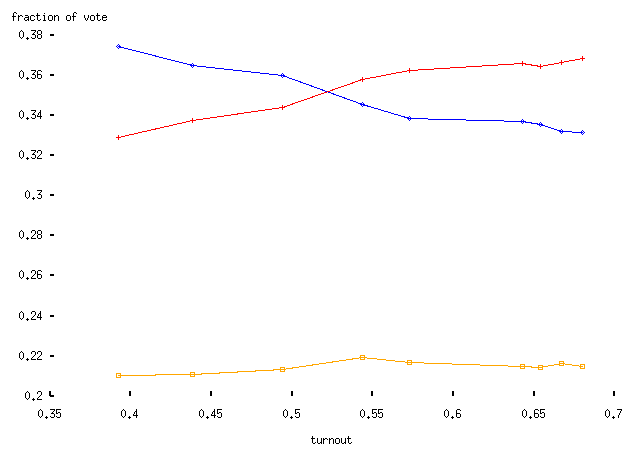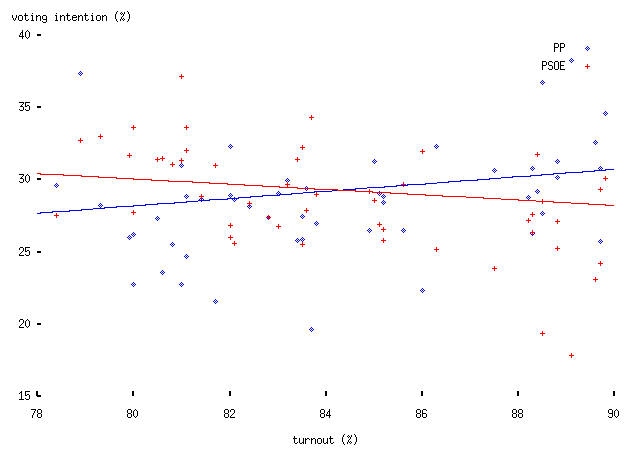Chris Brooke, Matthew Turner and others have put forward the theory that the most rational explanation for the defeat of Jose Maria Aznar in Sunday's Spanish elections was the increase in turnout occasioned by last Thursday's terrorist attacks in Madrid. The idea goes that, in Chris's words,
... when turnout rates rise in the context of a general democratic mobilisation, Left parties are more likely to benefit, given that it's the poor, the unemployed, the working class, the less well educated and so on who are, other things being equal, those who are less likely to cast a ballot[.]
This effect seems to work pretty well for British elections, or, at least, British opinion polls. The raw data from this ICM voting intention poll can be processed to give a plot of turnout against results like this:
by considering the various levels of turnout to be defined by the sum of the first n categories of likelihood to vote. (See also the discussion on this topic from Matthew's web log.)
Now, I haven't been able to find similar polling data for Spain (if you have some, I'd love to see it). But I have had a go at extracting some of the same voting intention data from this archive of Spanish opinion poll results maintained by the government of Valencia. Rather than analysing voting intention from a single poll stratified by confessed likelihood to vote, I've tried to analyse a bunch of polls by assuming that the fraction of people who say they will not vote is a good proxy for turnout in the election. Frankly this doesn't work very well, but it's the data we've got. Attempting the equivalent of the above plot gives, based on polling data from 2000 onwards: (the lines are best-fit regression lines)
(As an aside, I've used blue, like the Tories, for the Popular Party -- PP -- and red, like Labour, for the Socialist Party -- PSOE. I don't actually know what colours they use in Spanish politics, and evidently am too lazy to find out. I always find electoral maps of the United States confusing, since it would never occur to me that Republicans are red and Democrats blue. Such are the perils of multiculturalism, or something.)
Looking at the above plot, we can conclude that:
- The correlation between turnout and voting intention is pretty lousy; the regression also suffers from serious colinearity problems and should probably not be taken too seriously.
- That said, if we (unwisely) wanted to conclude anything from the above plot, it is that the supposed effect -- that increasing turnout increases vote share for the PSOE -- does not occur.
This is a surprise. As I say, without polling data which are broken down by likelihood to vote, or a less noisy timeseries, we can't really confirm this. But the increased-turnout-leads-to-PSOE-victory theory isn't supported by the evidence so far.
Update: Matthew Turner links to this UPI story, which states that an opinion poll on Wednesday 10th March, the day before the bombing, showed the PSOE in the lead by `less than a 2 percent margin' -- but in the lead nevertheless. So the `surprise result' may not have been a surprise, or even caused by terrorism.

